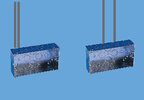Hi, looking for some guidance please,
I plan to install the back boxes and cutting out the chases in prep for the electrician - Complete re-wire, new CU etc etc, I'll be plastering over the cables as well.
Just wondering what's the preference these days, do we install 2 x 2.5mm T+E in the same 25mm KO - Or separate 20mm KO for each cable?
Internal wall 100mm, plan to use 35mm back boxes.
My gut feeling says they didn't provide the 25mm KO for nothing, but just thought I'd seek some advice thanks
I plan to install the back boxes and cutting out the chases in prep for the electrician - Complete re-wire, new CU etc etc, I'll be plastering over the cables as well.
Just wondering what's the preference these days, do we install 2 x 2.5mm T+E in the same 25mm KO - Or separate 20mm KO for each cable?
Internal wall 100mm, plan to use 35mm back boxes.
My gut feeling says they didn't provide the 25mm KO for nothing, but just thought I'd seek some advice thanks


